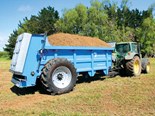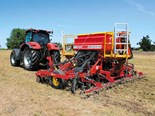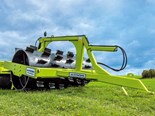Test: Pichon Spreader
Farm Trader visits Tahuna farmer Hendrik Drent's 70ha dairy farm to see the Pichon Spreader work it's magic
Tahuna farmer Hendrik Drent decided he wanted more flexibility with managing effluent on his 70ha dairy farm. Until four years ago, he relied on contractors to do the spreading for him with a tanker. This worked fine although he was finding it increasingly difficult to get them on-farm at the ideal time to suit ground and weather conditions.
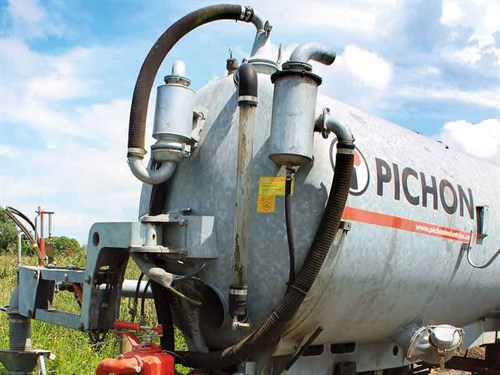
Investigating different options, he looked at installing a travelling irrigator. However this would require a new transformer for the electricity for a start, as well as the underground pipe work. While this system is common on dairy farms, and relatively easy to operate once established, it usually only covers a portion of the farm.
The other option was to purchase his own tanker; in this case a Pichon 10,000 litre unit from his local branch of Norwoods Farm Machinery in Morrinsville. Already owning a tractor suitable to operate the tanker and having the labour to operate ticked all the boxes for Hendrik in his operation.
Test
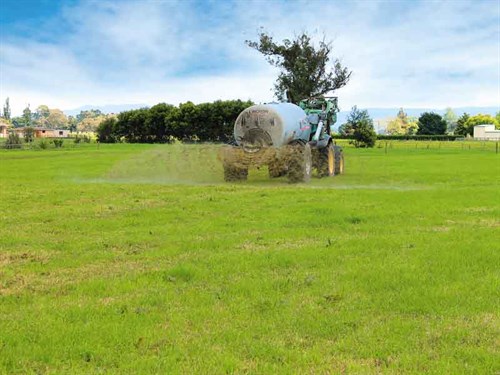
When I caught up with Hendrik and his manager Gavin, they were hard at it with the Pichon spreader. The property has a pond capable of holding 90-plus days worth of effluent. They aim to spend one day a month, or two days every second month spreading, so total time spent on effluent management each month is around 10-12hrs.
With the autofill arm they don’t have to get off the tractor when they fill up. When the pond is full, they can be loaded in around three minutes, and it takes between four and five minutes as the level in the pond drops below halfway.
Given that the farm is 70ha, with a centrally located shed, pond travel time to the paddock for spreading is minimal. A tankful takes a similar time to spread as it does to fill, so all up it’s between 10-15 minutes/load.
When initially looking at purchasing a tanker, Hendrik was looking at machines with capacity of 7500-8000 litres as he didn’t want the extra expense of replacing his 80hp tractor. Norwood Farm Machinery in Morrinsville had the 10,000 litre Pichon in stock at the time.
After trialling on-farm he decided the Pichon, with its extra capacity, was the way to go. With a flat farm, the 80hp tractor is operating at maximum and manages the job well.
With the loaded tanker being much heavier than the tractor, a careful and competent operator is required. If you were operating on anything but flat land you would require 120hp at a minimum. One of the things I was most impressed by with the large tanker on a relatively small tractor (by today’s standards), was how well it followed behind the tractor.

I put this down to a number of things; the large flotation tyres to soak up the bumps; adjustable axle setting to suit the tractor, so all the weight isn’t transferred to the drawbar; and the leaf spring suspension system incorporated into the drawbar of the Pichon, which does a great job.
Other factors like the condition of paddocks and races being in good order also help. Hendrik and Gavin usually aim to apply around 12mm with each application, but vary this with width between runs depending upon paddock conditions which are recorded in the farm diary.
Operation

Slurry tankers are pretty basic in terms of operation; the pump sucks to fill, and you change handle direction to pump the contents back out. Being a vacuum system, liquid or slurry doesn’t pass through the pump, so wear on the pump components is relatively minimal.
If you plan to use a slurry tanker to shift a serious amount of liquid, I would recommend going for the autofill arm system like Hendrik has on his Pichon. The initial extra cost would quickly be recouped in time saved getting on and off the tractor to couple and uncouple the tanker, which then affects the productivity of the job with the volume you are able to get spread in a given time.
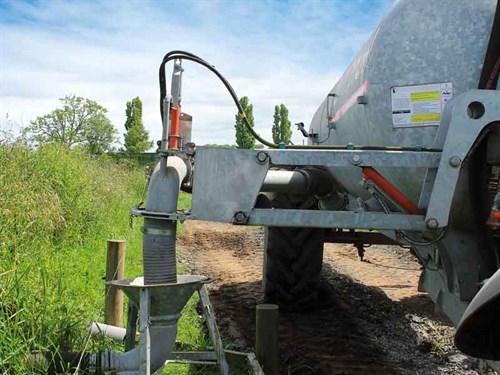
Sequencing of the hydraulics means you still only need two rear remotes; one for the rear outlet valve to open and shut, and the other to change the valve from pump to suck. You then lower the filling arm into the filling station base with the PTO running (at 540rpm) to create the suction. The final step is opening the valve on the arm.
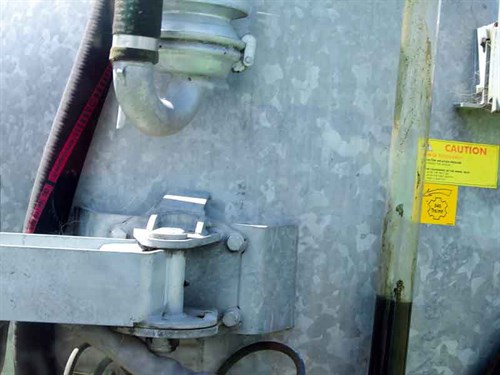
A clear sight glass tells you what level the tanker is up to when filling and spreading, as well as the obvious change in pump sound when full or empty. When the tank is full, all the hydraulic functions are just completed in reverse and the arm tucks back up, neatly out of the way.
Pichon tankers have outlets on either side so you could specify your auto fill arm to be fitted on either side straight from the factory.
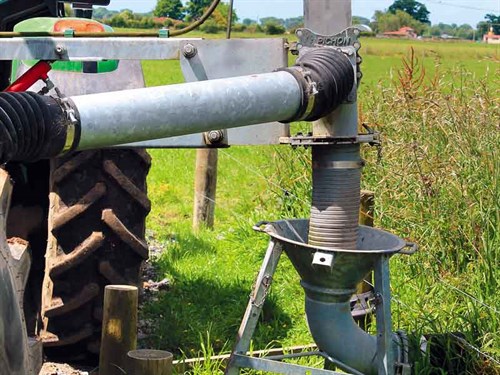
Maintenance
The service guys from Norwood Farm Machinery completed a service on Hendrik’s Pichon tanker after its initial run-in. Since then, a careful watch of oil levels on the pump and grease for the wheel bearings and PTO drive shaft has kept maintenance to a minimum.
The five-litre oil storage on the frame is a good idea, so the oil is right there with the machine should you need it. With the use of thick 6mm steel for the tank (galvanised inside and out), the corrosive nature of effluent has minimal likelihood of compromising the tank. There is a large rear hatch you can open to clean out the inside of the tank when required too.
Construction

As I mentioned above, the sensible choice of finish for effluent handling machinery is hot dip galvanised. Hendrik’s tanker doesn’t have mudguards, being a four year old model. But mudguards are now fitted by Pichon from new to keep the machine clean.
The guys at Pichon also don’t cut corners with the steel used; 5mm for the tank which is then securely mounted to the thick 10mm chassis. Two internal baffles are used on the 10,000 litre tankers to minimise slop and extra stress on chassis and tractor.
The Pichon tankers have three different mounting points for the axle on the single axle units which can be set to suit. Hendrik has found that with the middle setting, the tanker is well balanced for his tractor. I like the large single flotation tyres used to spread the weight, meaning the wheel width is similar to the tractor making it follow well through tight gateways.
Pichon fit the pumps best suited to the size of the machine at the factory before sending the units out to distributors for sale. Personally if this was my machine, I’d be more than happy with the performance of the tank and pump, given the filling and spreading time. Other good standard features are tail lights and indicators, should you want to take it down the road, and brakes for stopping safely.
About Pichon
Like many agricultural equipment manufacturers, Pichon is a family led business. As you may have guessed from the name, it is a French company based in Landivisiau, near Brest in western France. The company was started by Michel and Martine Pichon in 1970, originally focusing on cultivation equipment before moving into slurry tankers in 1976.
This gives them 40 years of experience in the industry. Today they are still making tanks from 2600-30,000-litres, with a variety of different spreading units available. With the change in farming systems in 2013, Pichon added solid muck spreaders to their range of slurry equipment, but sticking with their proven galvanised finish.
Available in 45 countries around the world, Pichon has reputation for producing the gear to get the dirty jobs done. In New Zealand Pichon can be purchased through Norwood Farm Machinery’s dealerships throughout the country.
With a strong presence through the wider rural communities, Norwoods are known for giving back in the form of sponsoring big events like The Young Farmers Competition, and also in smaller ways too. The Morrinsville branch, for example, sponsors the Tahuna Golf Club (where Hendrik is a keen player) and donates ride-on tractors to local schools and organisations.
Summary
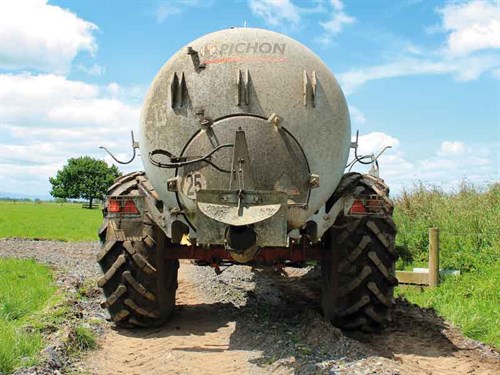
As I said in my opening paragraph, all farms have different infrastructure in place. I think Hendrik has found a great solution to effectively manage the effluent for his dairy farm with the Pichon 10,000-litre tanker. Having a simple to operate auto fill arm greatly increases the efficiency of what can be quite a time consuming job.
For me the build quality, especially the galvanised process used for the protection of the steel, is going to ensure many years of reliable service.
Pluses
- Galvanised finish (inside and out) is a sensible option.
- Easy to operate auto fill system
- Sprung drawbar and large flotation tyres for solid towing
Minuses
- No mudguards on Hendrik’s machine means mud can be thrown up off the wheels (however the latest models now come with mudguards)
Keep up to date in the industry by signing up to Farm Trader's free newsletter or liking us on Facebook





.jpg)
.jpg)




